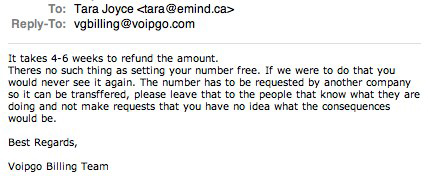
by Tara Joyce | May 21, 2009 | Cultural Creativity

I got duped. They seemed trustworthy. But I lost my money and my phone number. And then they insulted me.
This month I got entangled with a bogus VoIP provider. The email above is the only human interaction I was able to establish with them. They sure fooled me with their website.
They used all the ‘keys’ to building trust online.
Most websites use these 5 social proofs to get you to trust them:
1. A site that ‘looks good’.
Check. VoIPGo.com has a very professionally designed site. Perfectly designed to appear credible.
2. Has easy means of contact.
Check. VoIPGo.com allows you to contact them via email, mail, instant message and phone. If you want to speak to a human however, none of these will work.
3. Provides testimonials.
Check. VoIPGo.com even has some on the homepage. As well as on a VoIP review site. Testimonials are the easiest thing to fake.
4. Has an ironclad guarantee.
Check. 30 day money back guarantee. Just try and get them to honour it;)
5. Uses official website seals.
They missed this one. But 4 out of 5 ain’t bad.
But what do these ‘keys’ prove?
According to ‘web experts’, these 5 items are the key to developing trust online. And I actually fell for it. I trusted VoIPGo.com and they stole my money, my phone number and insulted me.
Which got me thinking, these 5 social proofs that apparently are so key to building trust, what purpose do they actually serve? As I’ve learned, they don’t actually prove that you can trust the person or company. VoIPGo.com is neither reliable, true, able, or strong.
These ‘keys’ are proofs of credibility, but they don’t build trust.
Which is different.
Don’t get into the business of proving your credibility, get into the business of building trust.
Testimonials, iron-clad guarantees, snappy tag lines and the like are all tools used to prove credibility. They are tools used to get you to trust and believe what the person or company is saying. But why should you have to convince your client of that? We’re in the business of building relationships and providing value. If you are authentic and good at what you do, that should be evident when a new client speaks to you.
Where trust actually comes from.
Connection. From developing a relationship. From talking with the person or company and deciding for yourself.
Build trust by authentically connecting with your audience. Instead of credibility proofs, show you understand your visitors pain. Show the values your stand by. Be evident of the kind of person and business you are.
And above all, encourage your audience to connect with you, in whatever way that suits you. Only through human connection can trust be built. I had to learn this the hard way. If I had ever bothered to talk with VoIPGo.com before signing up, I would have realized exactly what kind of company they are.
![My Goals for This Year: Growing Innerpreneurship in 2009]()
by Tara Joyce | Jan 2, 2009 | My Journey | What's On My Mind

Creative Commons License photo credit: Joe Dielis
I’ve never been one for New Year’s resolutions. I could never understand why the change in the date was a catalyst to make changes in my life. I always followed the plan that I would institute changes as soon as I was aware that they needed or wanted to be made.
But as another year ends and I enter my 28th year of life, I am understanding more the value of reflection and goal setting, both personally and professionally.
Reflection helps me to appreciate the journey and how it has lead me to where I am today, while goal setting helps me to outline my desires for the future and strategize how to achieve them.
I’ve realized that the advent of a new year is a great time to begin creating holistic solutions to the issues uncovered during the previous year.
Where I Want to Be in 2009
- Meditating Regularly
2008 was filled with multiple attempts to begin meditating regularly. Unfortunately, I found it nearly impossible to establish a routine that I could stick with. My goal for 2008 was to meditate daily but for 2009, I will be happy simply to have it be a growing activity in my life.
Any tips you may have on how you motivated yourself to meditate are very much appreciated.
- Generating a Sustainable Income from My Business, Elastic Mind
My business earnings in 2008 (from May onwards, when I started Elastic Mind) were minimal as I was focusing the bulk of my time on planting my business seeds. In 2009 I aim to generate enough income to 1. sustain the costs of running the business and 2. contribute to our living expenses.
Any tips you may have on how you cultivate clients are very much appreciated.
- Completing my Business Website
I am very proud of the site I am creating but now that the hard part is over (it has been designed and written), I am working on developing the site. This means coding, populating, editing and search engine optimizing the over 100+ pages I have conceptualized and written. It is a slow process and I daily feel the grind of the “creative hump”. Some days I worry that the site will “never” be finished.
Any tips you may have on how you stay focused and motivated on your creative projects are very much appreciated.
- Enjoying More Hobbies
I have plans to continue my tap dancing classes, to start take a drawing class and to read the 10 books sitting by my bed. Daniel and I are traveling to Nicaragua in February. I also plan to attend regular yoga/pilates classes and continue to walk as much as I have in 2008.
Any tips you may have on how you make time for your hobbies are very much appreciated.
- Developing More Daily Structure
It is an adjustment to move from a “9-to-5” life to that of an independent. I am still working on developing a structure to my day that ensures I yield maximum productivity while maintaining balance, calm and focus. I want to do away with the days where I never see daylight as I am too focused to take a break.
Any tips you may have on how you create structure in your day are very much appreciated.
- Taming My Inner Critic and Growing My Inner Kudos
Although I have achieved all the goals I set for myself 2008, it is not enough. I am never satisfied with my achievements. In fact, I am almost embarrassed and ashamed by them. I am hesitant to share with them with even those that are closest to me. I don’t know why and in 2009 I am going to work on ending the secrecy and cultivating a more self-promoting attitude.
Any tips you may have on how you became less secretive about your work are very much appreciated.
- Improving and Growing Rise of the Innerpreneur
I have many ideas for how I can continue to improve and better serve innerpreneurs through my blog, Rise of the Innerpreneur. In the coming weeks I will be asking you how this blog can be of more value to you. I want it to be the best it can be and to be constantly evolving with our changing needs.
If you have any tips on how I can improve the blog I would love to hear them.
Otherwise, in the coming weeks I will be asking your opinion on ideas I have had. I would appreciate it greatly if you provided feedback on them. I truly want this blog to be the most valuable tool it can be.
Now that I know where I want to be in 2009, I can begin the process of determining how I will get there.
![My Goals for This Year: Growing Innerpreneurship in 2009]()
by Tara Joyce | Oct 23, 2008 | Innerpreneurship

Creative Commons License photo credit: doug88888
- Many of us embraced innerpreneurialism after first trying (and disliking) more conventional careers and professions.
- We are credited with the rise in popularity of cause marketing.
The idea that businesses should give back has become more mainstream because of our influence on society.
- Innerpreneurs are credited with creating New Urbanism, a social movement against suburbanism.
In the heart of small cities like Portland, Oregon new communities are being built by innerpreneurs. In them, the houses are closer together, there are sidewalks and bike lanes and the community is a mixture of residential, office and retail. Glenwood Park in Atlanta, Georgia is a thriving example of what the New Urbanism movement has created.
- Sabbaticals are popular with innerpreneurs who can’t change careers completely.
Sabbaticals give part-time innerpreneurs a chance to explore parts of themselves that their career does not allow.
- Popular innerpreneurial pursuits include: life coach counseling, blogging, athletic challenges, volunteering and vacations with meaning.
- Notable innerpreneurs include:
Jaime Clarke – Adveturer-Lecturer
Nina Planck – Food Writer and Expert on Farmers Markets
Dr. Joseph Helms – Medical Innovator
Gary Hirshberg – CE-Yo of Stoneyfield Farm
Carlo Petrini – Founder of the Slow Food Movement
Jack Cogen – Environmental Financier
- While Cultural Creatives are members of the ‘creative class’, we are not the ‘creative class’.
The ‘creative class’ defines those who are employed in fields ranging from science and engineering to architecture and design, and from arts, music, and entertainment to the creative professions law, business and finance, health care and related fields. This class of people is defined by what they do, not by their world-views.
- A defining characteristic of Innerpreneurs, and Cultural Creatives in general, is our ability to see ourselves as part of something bigger.
We see that everything relates as an interwoven piece of nature. This way of thinking is called Systems Thinking.
- 60% of Cultural Creatives are women.
- There are two branches of Cultural Creative’s – Green CC’s and Core CC’s.
We are pretty much split down the middle with there being slightly more Green CC’s. Core CC’s are much more fascinated by personal growth and spirituality, as well as social activism.Green CC’s values are much more extroverted and less intensely held. And they tend to have a more traditional religious point of view. What we both share is our desire to make things better, both socially and environmentally. Innerpreneurs are members of the Core CC branch. While social entrepreneurs are members of the Green CC branch.
- We are no more liberal or conservative, left or right than the average Westerner.
We are what could best be described as retro-progressive, a combination of both ideals. This very fact will be our greatest tool in healing the current culture war between Modern and Traditional.
- A fair number of us belong to religious conservative denominations.
While most nonstandard believers of Eastern religions and spirituality are CC’s, they are a minority in the subculture. We are also Christians, Jews, Muslims, Buddhists, Chrisitan Scientists and agnotistics.
- Each of us followed the same 4 steps to becoming a Cultural Creative.
- We are not the first counterculture to defect from Modernism.
The Traditionals were the first, beginning their movement around 1870. This is interesting as it is contrary to the claims of Traditionals. They argue that Moderns were the ones who departed from what was conventional.
- Our movement is a healing movement.
We desire for things to be made whole. For mankind to wake up to their true desires.




